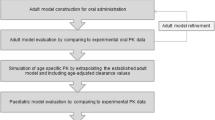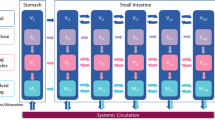Abstract
Inhibition of gastric emptying rate can have adverse effects on the absorption of food and nutrients. The absorption phase of the plasma concentration-time profile of a compound administered orally to pre-clinical species reflects among others, the gastric and intestinal transit kinetics, and can thus assist in the early identification of delayed gastric emptying. The purpose of this article is to demonstrate the value of Physiologically Based Pharmacokinetic (PBPK) modelling in the early identification of drug induced impairment of gastric emptying from pharmacokinetic profiles. To our knowledge, this is first time that the value of a generic PBPK model for hypothesis testing has been demonstrated with examples. A PBPK model built in-house using MATLAB package and incorporating absorption, metabolism, distribution, biliary and renal elimination models has been employed for the simulation of concentration-time profiles. PBPK simulations of a few compounds that are currently in drug discovery projects show that the observed initial absorption phase of their concentration-time profiles in rat were consistent with reduced gastric emptying rates. The slow uptake of these compounds into the systemic circulation is reflected in their pharmacokinetic profiles but it is not obvious until PBPK simulations are done. Delayed gastric emptying rates of these compounds in rats were also independently observed in x-ray imaging. PBPK simulations can provide early alerts to drug discovery projects, besides aiding the understanding of complex mechanisms that determine the lineshapes of pharmacokinetic profiles. The application of PBPK simulations in the early detection of gastric emptying problems with existing data and without the need to resort to additional animal studies, is appealing both from an economic and ethical standpoint.
Similar content being viewed by others
Abbreviations
- PBPK:
-
Physiologically based pharmacokinetics
- PK:
-
Pharmacokinetics
- iv:
-
Intravenous
- CL int :
-
Intrinsic clearance
- Kp :
-
Tissue–plasma partition coefficient
- pK a :
-
Dissociation constant
- log P :
-
Partition coefficient of a substance between lipid and water
- log D 6.8 :
-
Distribution coefficient of a substance between lipid and water at pH 6.8
- GE:
-
Gastric emptying
- P-gp:
-
P-glycoprotein
- AUC:
-
Area under the curve
- GI:
-
Gastrointestinal
- SI:
-
Small intestinal
References
Kido T, Nakai Y, Kase Y, Sakakibara I, Nomura M, Takeda S and Aburada M (2005). Effects of rikkunshi-to, a traditional Japanese medicine, on the delay of gastric emptying induced by N(G)-nitro-L-arginine. J Pharmacol Sci 98: 161–167
Wallden J, Thorn SE and Wattwil M (2004). The delay of gastric emptying induced by remifentanil is not influenced by posture. Anesth Analg 99: 429–434
Calatayud S, Garcia-Zaragoza E, Hernandez C, Quintana E, Felipo V, Esplugues JV and Barrachina MD (2002). Down regulation of nNOS and synthesis of PGs associated with endotoxin-induced delay in gastric emptying. Am J Physiol Gastrointest Liver Physiol 283: G1360–G1367
Cho SH, Park H, Kim JH, Ryu YH, Lee SI and Conklin JL (2006). Effect of sildenafil on gastric emptying in healthy adults. J Gastroenterol Hepatol 21: 222–226
Djaldetti R, Ziv I and Melamed E (1996). Impaired absorption of oral levodopa:a major cause for response fluctuations in Parkinson’s disease. Isr J Med Sci 32: 1224–1227
Harasawa S, Kikuchi K, Senoue I, Nomiyama T and Miwa T (1982). Gastric emptying in patients with gastric ulcers–effects of oral and intramuscular administration of anticholinergic drug. Tokai J Exp Clin Med 7: 551–559
Bozkurt A, Deniz M and Yegen BC (2000). Cefaclor, a cephalosporin antibiotic, delays gastric emptying rate by a CCK-A receptor-mediated mechanism in the rat. Br J Pharmacol 131: 399–404
Murphy DB, Sutton JA, Prescott LF and Murphy MB (1997). Opioid-induced delay in gastric emptying: a peripheral mechanism in humans. Anesthesiology 87: 765–770
Christian L and Andreas R (2005). Development and application of physiologically based pharmacokinetic modelling tools to support drug discovery. Chemistry and biodiversity 2: 1462–1486
Nestorov I (2003). Whole body pharmacokinetic models. Clin Pharmacokinet 42: 883–908
Charnick SB, Kawai R, Nedelman JR, Lemaire M, Niederberger W and Sato H (1995). Perspectives in pharmacokinetics. Physiologically based pharmacokinetic modeling as a tool for drug development. J Pharmacokinet Biopharm 23: 231–235
Bernareggi A and Rowland M (1991). Physiologic modeling of cyclosporin kinetics in rat and man. J Pharmacokinet Biopharm 19: 21–50
Rodgers T, Leahy D and Rowland M (2005). Physiologically based pharmacokinetic modeling 1: Predicting the tissue distribution of moderate-to-strong bases. J Pharm Sci 94: 1259–1276
Rodgers T and Rowland M (2006). Physiologically based pharmacokinetic modeling 2: Predicting the tissue distribution of acids, very weak bases, neutrals and zwitterions. J Pharm Sci 95: 1238–1257
Agoram B, Woltosz WS and Bolger MG (2001). Predicting the impact of physiological and biochemical processes on oral drug availability. Adv Drug Deliv Rev 50: S41–S67
Winiwarter S, Bonham NM, Ax F, Hallberg A, Lennernas H and Karlen A (1998). Correlation of human jejunal permeability (in vivo) of drugs with experimentally and theoretically derived parameters. A multivariate data analysis approach. J Med Chem 41: 4939–4949
Kawai R, Lemaire M, Steimer J-L, Bruelisauer A, Niederberger W and Rowland M (1994). Physiologically based pharmacokinetic study on a cyclosporin derivative, SDZ IMM 125. J Pharmacokinet Biopharm 22: 327–365
Davies B and Morris T (1993). Physiological parameters in laboratory animals and humans. Pharm Res 10: 1093–1095
Brown RP, Delp MD, Lindstedt ST, Rhomberg LR and Beliles RP (1997). Physiological parameter values for physiologically based pharmacokinetic models. Toxicol Ind Health 13: 407–484
Haruta S, Kawai K, Jinnouchi S, Ogawara K-I, Higaki K, Tamura S, Arimori K and Kimura T (2001). Evaluation of absorption kinetics of orally administered theophylline in rats based on gastrointestinal transit monitoring by gamma scintigraphy. J Pharm Sci 90: 464–473
Oberle RL, Chen TS, Lloyd C, Barnett JL, Owyang C, Meyer J and Amidon GL (1990). The influence of the interdigestive migrating myoelectric complex on the gastric emptying of liquids. Gastroenterology 99: 1275–1282
Yu LX and Amidon GL (1998). Characterization of small inetstinal transit time distribution in humans. Int J Pharm 171: 157–163
Nielson MA, Bayati A and Mattsson H (2006). Wistar Kyoto rats have impaired gastric accommodation compared to Sprague Dawley rats due to increased vagal cholinergic tone. Scand J Gastroenterology 41: 773–781
Washington N, Washington C and Wilson CG (2001). Physiological Pharmaceutics—barrier to drug absorption. Taylor and Francis, New York
Willmann S, Schmitt W, Keldenich J and Dressman JB (2003). A physiologic model for simulating gastrointestinal flow and drug absorption in rats. Pharm Res 20: 1766–1771
Oberle RL and Amidon GL (1987). The influence of variable gastric emptying and intestinal transit rate on the plasma level curve of cimetidine: An explanation of the double peak phenomenon. J Pharmacokinet Biopharm 15: 529–544
DeSesso JM and Jacobson CF (2001). Anatomical and physiological parameters affecting gastrointestinal absorption in humans and rats. Food Chem Toxicol 39: 209–228
Eastman IM and Miller EG (1935). Gastrointestinal pH in rats as determined by the glass electrode. J Biol Chem 110: 255–262
Lui CY, Amidon GL, Bereardi RR, Fleisher D, Youngberg C and Dressman JB (1986). Comparison of gastrointestinal pH in dogs and humans: implications on the use of beagle dogs as a model for oral absorption in humans. J Pharm Sci 75: 271–274
Crouthamel WG, Abolin CR, Hsieh J and Lim JK (1975). Intestinal pH as a factor in selection of animal models for bioavailability testing. J Pharm Sci 64: 1726–1727
Fallingborg J (1999). Intraluminal pH of the human gastrointestinal tract. Dan Med Bull 46: 183–196
Lin HC and Visek WJ (1991). Large intestinal pH and ammonia in rats: dietary fat and protein interactions. J Nutr 121: 832–843
Fagerholm U, Lindhal A and Lennernas H (1997). Regional intestinal permeability in rats of compounds with different physicochemical and transport mechanisms. J Pharm Pharmacol 49: 687–690
Oh DM, Cxurl RL and Amidon GL (1993). Estimating the fraction dose absorbed from suspensions of poorly soluble compounds in humans: a mathematical model. Pharm Res 10: 264–270
Popovic V and Popovic P (1960). Permanent cannulation of aorta and vena cava in rats and ground squirrels. J appl Physiol 15: 727–728
Brage R, Cortijo J, Esplugues J, Esplugues JV, Marti-Bonmati E and Rodriguez C (1986). Effects of calcium channel blockers on gastric emptying and acid secretion of the rat in vivo. Br J Pharmacol 89: 627–633
Yavorski RT, Hallgren SE and Blue PW (1991). Effects of verapamil and diltiazem on gastric emptying in normal subjects. Dig Dis Sci 36: 1274–1276
Author information
Authors and Affiliations
Corresponding author
Rights and permissions
About this article
Cite this article
Peters, S.A., Hultin, L. Early identification of drug-induced impairment of gastric emptying through physiologically based pharmacokinetic (PBPK) simulation of plasma concentration-time profiles in rat. J Pharmacokinet Pharmacodyn 35, 1–30 (2008). https://doi.org/10.1007/s10928-007-9073-1
Received:
Accepted:
Published:
Issue Date:
DOI: https://doi.org/10.1007/s10928-007-9073-1




